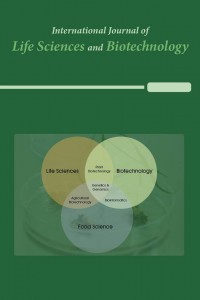Farklı Priming Uygulamalarının Patlıcan (Solanum melongena L.) Çeşitlerinin Tohumları Üzerindeki Etkinliği
Solanum melongena L., , priming, germination
The Effectiveness of Different Priming Treatments on Seeds of Eggplant (Solanum melongena L.) Varieties
Solanum melongena L., , priming, germination,
___
- Referans 1 Arabacı, Ç., KAPSAİSİNİN BİBERDE (Capsicum annuum L.) ÇİMLENME, ÇIKIŞ ve BİTKİ GELİŞİMİNE ETKİSİ. 2015, Namık Kemal Üniversitesi.
- Referans 2 Argerich, C.A.a.B., K.J, The effects of priming and ageing on seed vigour in tomato. Journal of Experimental Botany, 1989. 40.
- Referans 3 Ashraf, M.a.F., M. R.,, Pre-sowing seed treatment: A shotgun approach to improve germination, plant grow than dcrop yield undersaline and non-saline conditions. Advances in Agronomy, 2005. 88.
- Referans 4 Basra, S.M.A., N. Zia, T. Mahmood, A. Afzaland A. Khaliq, , Comparison of different in vigorati on techniques in wheat (Triricumaestivum L.) seeds. Pak. Journal of Arid Agriculture, 2003. 5.
- Referans 5 Bradford, K., Seed Production and Quality, College of Agricultural & Enviromental Sciences, p: 31-57. 2004.
- Referans 6 Bradford, K.J., Manipulation of seed water relations via osmotic priming to improve germination under stress conditions. HortScience (USA), 1986.
- Referans 7 Delouche, J.C., Environmental effects on seed development and seed quality. 1980.
- Referans 8 FAO. Patlıcan üretim miktarı 2018 17.09.2020]; Available from: http://www.fao.org/faostat/en/#data/QC.
- Referans 9 Farooq, M., et al., Thermal hardening: a new seed vigor enhancement tool in rice. Journal of Integrative Plant Biology, 2005. 47(2): p. 187-193.
- Referans 10 H, P., Tohum Önçimlendirme Uygulamalarından Ticari (Hazır) Fide Üretiminde Yararlanma Olanaklarının Belirlenmesi, in Fen Bilimleri Enstitüsü. 2008, Ege Üniversitesi
- Referans 11 Harris, D., et al., On-farm seed priming in semi-arid agriculture: development and evaluation in maize, rice and chickpea in India using participatory methods. Experimental Agriculture, 1999. 35(1): p. 15-29.
- Referans 12 Heydecker, W. and P. Coolbear, Seed treatments for improved performance survey and attempted prognosis. Seed science and technology, 1977.
- Referans 13 Hsu, C., et al., Accelerated aging-enhanced lipid peroxidation in bitter gourd seeds and effects of priming and hot water soaking treatments. Scientia Horticulturae, 2003. 98(3): p. 201-212.
- Referans 14 Huang, Y.M., H.H. Wang, and K.H. Chen, Application of seed priming treatments in spinach (Spinacia oleracea L.) production. J. Chinese Soc. Hort Sci, 2002. 48: p. 117-123.
- Referans 15 Khalil, S., H. Moursy, and S. Saleh, Wheat plant reactions to pre–sowing heat hardening of grains. II. Changes in photosynthetic pigments, nitrogen and carbohydrate metabolism. Bull Egyptian Soc Physiol Sci, 1983. 3: p. 161-175.
- Referans 16 Khan, A.A., Preplant physiological seed conditioning. Horticultural reviews, 1992. 13(1): p. 131-181.
- Referans 17 Lin, J. and J. Sung, Pre-sowing treatments for improving emergence of bitter gourd seedlings under optimal and sub-optimal temperatures. 2001.
- Referans 18 Liptay, A. and N. Zariffa, Testing the morphological aspects of polyethylene glycol-primed tomato seeds with proportional odds analysis. HortScience, 1993. 28(9): p. 881-883.
- Referans 19 Liu, Y., et al., X-ray studies on changes in embryo and endosperm morphology during priming and imbibition of tomato seeds. Seed Science Research, 1993. 3(3): p. 171-178.
- Referans 20 McDonald, M.B., Seed priming. Seed technology and its biological basis. Sheffield Academic Press, Sheffield, 2000: p. 287-325.
- Referans 21 Parera, C. and D. Cantliffe, Seed priming: A pre-sowing seed treatment. Hort. Rev, 1994. 16: p. 109-141.
- Referans 22 Shivankar, R., D. Deore, and N. Zode, Effect of pre-sowing seed treatment on establishment and seed yield of sunflower. JOURNAL OF OILSEEDS RESEARCH., 2003. 20: p. 299-300.
- Referans 23 Taylor, A. and G. Harman, Concepts and technologies of selected seed treatments. Annual Review of Phytopathology, 1990. 28(1): p. 321-339.
- Referans 24 TUIK. Patlıcan üretim miktarı 2019 17.09.2020]; Available from: https://biruni.tuik.gov.tr/medas/?kn=92&locale=tr.
- Referans 25 Venkatasubramanian, A. and R. Umarani, Evaluation of seed priming methods to improve seed performance of tomato (Lycoperison esculentum), egg plant (Solanum melongena) and chilli (Capsicum annum). Seed Science and technology, 2007. 35(2): p. 487-493.
- Referans 26 Wang, H., C. Chen, and J. Sung, Both warm water soaking and matriconditioning treatments enhance anti-oxidation of bitter gourd seeds germinated at sub-optimal temperature. Seed Science and Technology, 2003. 31(1): p. 47-56.
- Referans 27 WARD, F.H. and A.A. POWELL, Evidence for repair processes in onion seeds during storage at high seed moisture contents. Journal of Experimental Botany, 1983. 34(3): p. 277-282.
- Referans 28 WELBAUM, G.E. and K.J. BRADFORD, Water relations of seed development and germination in muskmelon (Cucumis melo L.) VI. Influence of priming on germination responses to temperature and water potential during seed development. Journal of Experimental Botany, 1991. 42(3): p. 393-399.
- Yayın Aralığı: Yılda 3 Sayı
- Başlangıç: 2018
- Yayıncı: International Society of Academicians
Yusuf JACOB AKURE, Maryam AHMED, Hyelni BUKAR, Gingsami SİMON
Polymorphism of Alpha S1-Casein Gene in Yankasa Sheep Breed of Mubi, Adamawa State of Nigeria
İsmaila Yada SUDİ, Shuaibu MOHAMMED, Malachi TİZHE, Clément AUGUSTİNE
Isolation of Antibiotic Resistant Bacteria from Rivers in Kelantan, Malaysia
Nurul Liyana HASSAN, Kam KAR YERN, Nor Azimah MOHD ZAİN
Gisela 6 ve SL 64 Anaçlarının İn vitro Koşullarda Çoğalma Performanslarının Belirlenmesi
Erol AYDIN, Belgin TURUNÇ, Tarık YARILGAÇ
Mümine GURUK, Mehmet KARAASLAN
Olcay GENÇYILMAZ, Gamze SEÇKİN
Isolation of Antibiotic Resistant Bacteria from Rivers in Terengganu, Malaysia
Nurul Aqidah SALİKAN, Nor Azimah MOHD ZAİN, Kam KAR YERN
Biberlerde Türler Arası Melezleme
